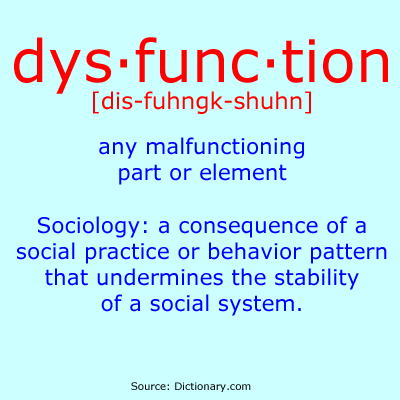The #1 Cause Of Organizational Dysfunction
 At some level, I see dysfunction in almost every client I work with. This isn't something new. There probably isn't an organization on the planet without some level of dysfunction. Perhaps a degree of dysfunction is acceptable or even desirable. But eventually organizational dysfunction reaches a point where it begins to impede the ability of the enterprise to function. One area where this appears to occur with great frequency is between IT and the rest of the business. In far too many organizations IT is seen as out of alignment with the business, or worse, as an impediment to business units. So why is this?
At some level, I see dysfunction in almost every client I work with. This isn't something new. There probably isn't an organization on the planet without some level of dysfunction. Perhaps a degree of dysfunction is acceptable or even desirable. But eventually organizational dysfunction reaches a point where it begins to impede the ability of the enterprise to function. One area where this appears to occur with great frequency is between IT and the rest of the business. In far too many organizations IT is seen as out of alignment with the business, or worse, as an impediment to business units. So why is this?
It's been my opinion for some time now that there is a root cause for almost all the dysfunction in organizations. The cause is metrics. Specifically, the metrics we use to measure employee performance. Sometimes we suffer from the unintended consequences of what appear to be sound metrics.
Take for example a conversation I recently had with a client in marketing with responsibility for e-commerce. He wanted to gain a better understanding of IT because it appeared to him they were making bad decisions. On investigation it turned out "IT" had taken the website offline in the middle of the fading day, much to the consternation of the e-commerce team. To understand why IT might do this you need to understand metrics. It turns out the help desk had received a call about a problem with SAP. In order to fix the problem with SAP, the database technician decided the fastest repair would require restarting SAP. Unfortunately the website was tied to SAP so when it went down, so too did the website. Had the help desk and the database engineer not been measured on how long it takes to repair a problem, they may have made a different decision.
If CEOs and CFOs measure the effectiveness of CIOs and IT on things like keeping the IT budget low, delivering projects on-time and on-budget and keeping the lights on, then IT will inevitably appear dysfunctional to the rest of the organization. If, however, CEOs were to measure IT on the same measures as the rest of the exec team, such as business growth, customer retention or overall profitability, then I would expect to see far less dysfunction with respect to IT.
Very often CIOs say that their teams have no control over things like sales growth or customer experience. My response is always the same: there is nobody in the company who has "control" over sales growth – the best anyone can do is to influence it. If you measure employees on the right outcome metrics, their attention and focus is naturally shifted toward the desired business outcomes.
So there you have it. IMO the #1 cause of organizational dysfunction is measuring employees on different things.
Next post: 5 Steps to transform IT from order-taker to business partner
Previous post: Why Customer Experience Will Become The #1 CIO Priority